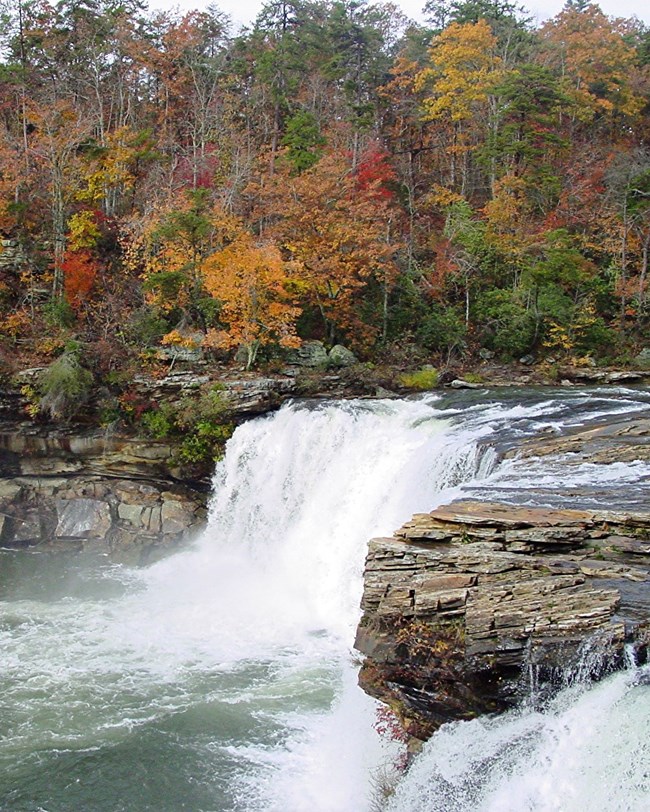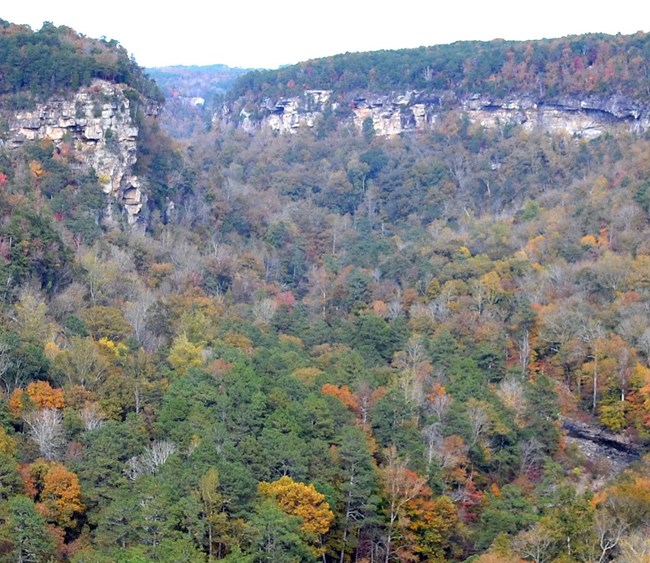Last updated: July 10, 2024
Article
NPS Geodiversity Atlas—Little River Canyon National Preserve, Alabama
Geodiversity refers to the full variety of natural geologic (rocks, minerals, sediments, fossils, landforms, and physical processes) and soil resources and processes that occur in the park. A product of the Geologic Resources Inventory, the NPS Geodiversity Atlas delivers information in support of education, Geoconservation, and integrated management of living (biotic) and non-living (abiotic) components of the ecosystem.

Introduction
Established on October 21, 1992, Little River Canyon National Preserve protects natural, scenic, recreational, and cultural resources in one of the most extensive canyon and gorge systems in the eastern United States. The NPS manages 5,517.06 ha (13,632.95 ac) in partnership with the Alabama state park system. The park is within the Valley and Ridge province of northeastern Alabama, a part of the Appalachian-Alleghanian orogenic belt.
Geologic Features and Processes
Exposed within Little River Canyon National Preserve are basal Pennsylvanian sedimentary rocks of the Pottsville Formation. The lower portions of this unit contain massive, conglomeratic, quartzrich sandstone, shale, coal, and mudstone beds deposited in prodelta, barrier and back-barrier depositional environments. The upper portions of the Pottsville contain resistant, crossbedded, quartz-rich conglomerates and sandstones deposited within a fluvial-dominated deltaic system creating repetitive sequences of coals, shales, and sands. The canyon cuts into underlying Mississippian carbonates.

Little River Canyon is incised through the Lookout Mountain syncline. This eroded broad syncline plunges gently towards the southwest and has approximately 305 m (1,040 ft) of topographic relief. The syncline formed during the last major mountain building event in the southern Appalachians—the Pennsylvanian-Permian Alleghanian orogeny. This event involved continental collision, massive regional uplift, subduction of oceanic crust, magmatism, and extensive thrust faulting and associated folding. The Valley and Ridge province in Alabama sits above a large-scale decollement (thinskinned detachment) along which tectonic forces pushed the Paleozoic-age folded and faulted rocks westward. Rome fault dissects Lookout Mountain to the south.
The landscape at the preserve varies from gently undulating upland areas to sheer vertical cliffs to the narrow canyon floor. Outcrop exposures at Little River Canyon with sandstone glades, steep rocky trails, and shear cliffs are abundant. The Little River and its tributaries including Wolf Creek, Bear Creek, Johnnies Creek, and Yellow Creek dominate the landscape at the park. The interaction between these waterways and the underlying geology has created spectacular scenery in the preserve such as Little River Canyon, 14-m (45-ft) high Little River Falls, and Graces High Falls. This scenery can be seen from places such as Canyon View, Lynn, Hawks Glide, Crow Point, Eberhart Point, and other overlooks along Canyon Rim Drive.
Regional Geology
Little River Canyon National Preserve is a part of the Appalachian Plateaus Physiographic Province and shares its geologic history and some characteristic geologic formations with a region that extends well beyond park boundaries.
- Scoping summaries are records of scoping meetings where NPS staff and local geologists determined the park’s geologic mapping plan and what content should be included in the report.
- Digital geologic maps include files for viewing in GIS software, a guide to using the data, and a document with ancillary map information. Newer products also include data viewable in Google Earth and online map services.
- Reports use the maps to discuss the park’s setting and significance, notable geologic features and processes, geologic resource management issues, and geologic history.
- Posters are a static view of the GIS data in PDF format. Newer posters include aerial imagery or shaded relief and other park information. They are also included with the reports.
- Projects list basic information about the program and all products available for a park.
Source: NPS DataStore Saved Search 3007. To search for additional information, visit the NPS DataStore.
A NPS Soil Resources Inventory project has been completed for Little River Canyon National Preserve and can be found on the NPS Data Store.
Source: NPS DataStore Saved Search 3054. To search for additional information, visit the NPS DataStore.
Related Articles
Little River Canyon National Preserve
National Park Service Geodiversity Atlas
The servicewide Geodiversity Atlas provides information on geoheritage and geodiversity resources and values within the National Park System. This information supports science-based geoconservation and interpretation in the NPS, as well as STEM education in schools, museums, and field camps. The NPS Geologic Resources Division and many parks work with National and International geoconservation communities to ensure that NPS abiotic resources are managed using the highest standards and best practices available.


